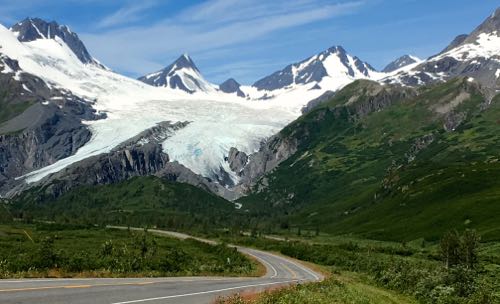 Thompson Pass
Thompson Pass
Worthington Glacier
The road to Valdez, (a port town with a name famous for the Exxon Valdez Oil Spill) passes through some spectacular glacial scenes. The Worthington Glacier sits atop the mountain pass and serves as another warning sign that we are warming our planet rather too quickly for our earth's systems to adapt.
Scientists have been tracking the movement of Worthington's ice by boring holes into the ice and inserting time-lapse video cameras. Information collected from these cameras reveal how ice crystals form as well as the direction and speed of ice flow. It is clear that the earth's warming is causing the ice to melt faster than winter snow fall can replace it. In the recent past, Worthington's ice reached the highway. From the photo below, you can see that the glacier has retreated significantly since the highway was built.
 Retreating Worthington
Retreating Worthington
Ice Worms??!
After seeing first hand at the Yellowstone Geysers how life can adapt to extreme conditions, I was still taken aback when I visited Worthington and learned that even annelids (segmented worms) can cling to life and even prefer the frozen world over more temperate conditions.
Little is known about these strange worms. To date, only two species are known to exist. As their scientific name describes, Mesenchytraeus solifugus, they are sun avoiding, even in temperatures that reach forty below! They are only a half inch long and "thin as thread". These skinny little worms attach one end of their bodies to the ice and wriggle and wave their other end along the ice to collect food particles that might have been dislodged by the glacial ice. Weird and wonderful life!
 Ice Worm Cartoon
Ice Worm Cartoon
 Ice worm
Ice worm
